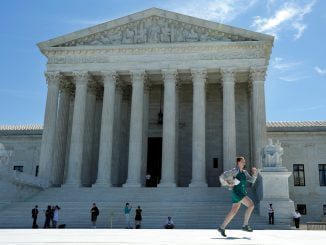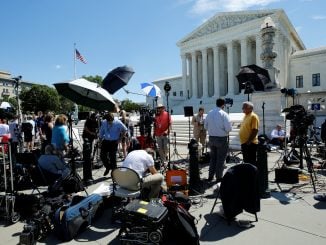
WASHINGTON, D.C. — With Brett Kavanaugh’s nomination in limbo, a shorthanded Supreme Court appeared evenly split Monday over a potential habitat for an endangered frog in the first arguments of the new term.
The arguments and the appearance of the eight justices on the bench — an empty place on the far right where a ninth would sit — underscored the unusual environment in which the high court began its new term.
Republicans had hoped to have Kavanaugh confirmed in time for Monday’s session, an addition that could cement conservative control of the court. But the vote on Kavanaugh’s nomination has been delayed while the FBI investigates allegations against him of sexual misconduct.
The case argued Monday morning concerns a dispute over Louisiana timberland that was designated as critical habitat under the Endangered Species Act for the dusky gopher frog, even though the frog is found only in Mississippi.
The conservative justices appeared sympathetic to the Weyerhaeuser Co. timber company that sued over the designation while liberals seemed inclined to back the government.
And even though the absence of a justice can prod the court to compromise, pointed disagreements between the two sides of the court emerged in the course of the hourlong arguments.
Justice Elena Kagan said the company seemed to be arguing that the Endangered Species Act “would prefer extinction of the species to the designation of an area which requires only certain reasonable improvements in order to support the species.”
But a few minutes later, Justice Samuel Alito jabbed at Kagan. “Now this case is going to be spun, we’ve already heard questions along this line, as a choice between whether the dusky gopher frog is going to become extinct or not. That’s not the choice at all,” Alito said, adding that the only issue is whether private landowners or the government is going to pay to preserve land that could support an endangered species.
The justices could hold onto the case and order a new round of arguments once the bench is full or resolve the case narrowly. If the court is tied on a decision, it would only affirm a lower court’s ruling. If Kavanaugh were to be confirmed, he can be seated mid-session.
“The only cases that he would not be involved in would be the cases that have already been argued in the court,” said Greg Wallace, law professor at Campbell Law School.
When the court met just after 10 a.m., it was the first time in more than 30 years without Justice Anthony Kennedy, who retired over the summer. Kennedy was considered the swing vote on the court during his decades on the bench. If Kavanaugh were to replace him, analysts say he isn’t likely to take the same role.
“He’ll be more reliably conservative thank justice Kennedy,” said Wallace. “If there is going to be a swing vote that develops on the court, like we had with Justice Kennedy, it will be much more likely Chief Justice Roberts than a Justice Kavanaugh.”
Chief Justice John Roberts proclaimed the end of the last term and the start of the new one, then briefly congratulated Justice Ruth Bader Ginsburg on her 25 years on the court.
“We all look forward to sharing many more years with you in our common calling,” Roberts told the 85-year-old Ginsburg, who now sits immediately to Roberts’ left in the court’s seniority-based seating plan.
Justice Clarence Thomas, the longest-serving member of the current court, was to Roberts’ right. Ginni Thomas, the justice’s wife, watched the morning arguments from seats reserved for justices’ guests.
It was mostly business as usual. The justices turned down roughly 1,400 appeals that had been awaiting decision over the summer. Lawyers were sworn in as members of the Supreme Court bar.
As the session continues, the court isn’t likely to tackle the type of high-profile cases they took on last session; NAMES – But North Carolina’s district maps could make their way to the high court.
“There are a list of very important cases, there is of course the North Carolina partisan gerrymandering case that the court could take up, there is a challenge that’s percolating regarding President Trump’s cancellation of the DACA program,” said Wallace. “There is also a very interesting case the court has been asked here about the interpretation of anti-discrimination law and the argument there is, does sex discrimination include discrimination based gender identity? … we will keep an eye out for those.”
Decisions on the cases generally come three to four months after they are argued during the session.
The Associated Press contributed to this report.



